Thanksgiving turkey dinners are always a hit, so make sure you serve your guests the best turkey you can! Oven baked turkey is good, but it can’t compare to a perfectly smoked turkey!
Smoking a turkey is a great way to achieve a flavorful and juicy bird. However, many people wonder if they should spritz their turkey while it smokes. Spritzing is the process of spraying the turkey with a liquid solution during the smoking process This can help to keep the turkey moist and prevent it from drying out.
Should I Spritz My Smoked Turkey?
The answer to this question depends on a few factors, including the type of smoker you are using, the temperature you are smoking at, and your personal preferences.
Smoker Type
If you are using a smoker that tends to run dry, such as a charcoal smoker, then spritzing your turkey can be helpful. This will help to add moisture to the air and prevent the turkey from drying out.
On the other hand, if you are using a smoker that tends to run more humid such as an electric smoker, then spritzing your turkey may not be necessary. In fact, it could even make the turkey soggy.
Smoking Temperature
The temperature at which you are smoking your turkey will also affect whether or not you need to spritz it. If you are smoking at a low temperature, such as 225 degrees Fahrenheit, then spritzing your turkey can be helpful. This will help to keep the turkey moist and prevent it from drying out.
However, if you are smoking at a higher temperature, such as 325 degrees Fahrenheit, then spritzing your turkey may not be necessary. In fact, it could even make the turkey tough.
Personal Preferences
Ultimately the decision of whether or not to spritz your smoked turkey is up to you. Some people prefer to spritz their turkeys, while others do not. There is no right or wrong answer.
Spritzing Solutions
If you decide to spritz your smoked turkey, there are a few different solutions that you can use. Some popular options include:
- Apple cider vinegar
- Apple juice
- Chicken broth
- Beer
- Wine
You can also add other ingredients to your spritz solution, such as herbs, spices, or fruit juices.
Tips for Spritzing
Here are a few tips for spritzing your smoked turkey:
- Use a spray bottle to apply the spritz solution.
- Spritz the turkey every 30-60 minutes.
- Avoid over-spritzing the turkey, as this can make it soggy.
- Stop spritzing the turkey about an hour before it is done cooking.
Whether or not to spritz your smoked turkey is a personal decision. There are pros and cons to both sides, so it is important to weigh your options and decide what is best for you. If you do decide to spritz your turkey, be sure to use a solution that you like and follow the tips above.
Frequently Asked Questions
What is the best spritz solution for a smoked turkey?
There is no one-size-fits-all answer to this question, as the best spritz solution for a smoked turkey will vary depending on your personal preferences. However, some popular options include apple cider vinegar, apple juice, chicken broth, beer, and wine. You can also add other ingredients to your spritz solution, such as herbs, spices, or fruit juices.
How often should I spritz my smoked turkey?
You should spritz your smoked turkey every 30-60 minutes. However, you may need to adjust this frequency depending on the type of smoker you are using and the temperature at which you are smoking.
When should I stop spritzing my smoked turkey?
You should stop spritzing your smoked turkey about an hour before it is done cooking. This will allow the skin to crisp up.
Smoking a turkey is a great way to achieve a flavorful and juicy bird. However, many people wonder if they should spritz their turkey while it smokes. Spritzing is the process of spraying the turkey with a liquid solution during the smoking process. This can help to keep the turkey moist and prevent it from drying out.
The answer to this question depends on a few factors, including the type of smoker you are using, the temperature you are smoking at, and your personal preferences. If you are using a smoker that tends to run dry, then spritzing your turkey can be helpful. This will help to add moisture to the air and prevent the turkey from drying out.
On the other hand, if you are using a smoker that tends to run more humid, then spritzing your turkey may not be necessary. In fact, it could even make the turkey soggy.
The temperature at which you are smoking your turkey will also affect whether or not you need to spritz it. If you are smoking at a low temperature, such as 225 degrees Fahrenheit, then spritzing your turkey can be helpful. This will help to keep the turkey moist and prevent it from drying out.
However, if you are smoking at a higher temperature, such as 325 degrees Fahrenheit, then spritzing your turkey may not be necessary. In fact, it could even make the turkey tough.
Ultimately, the decision of whether or not to spritz your smoked turkey is up to you. Some people prefer to spritz their turkeys, while others do not. There is no right or wrong answer.
If you decide to spritz your smoked turkey, there are a few different solutions that you can use. Some popular options include:
- Apple cider vinegar
- Apple juice
- Chicken broth
- Beer
- Wine
You can also add other ingredients to your spritz solution, such as herbs, spices, or fruit juices.
Here are a few tips for spritzing your smoked turkey:
- Use a spray bottle to apply the spritz solution.
- Spritz the turkey every 30-60 minutes.
- Avoid over-spritzing the turkey, as this can make it soggy.
- Stop spritzing the turkey about an hour before it is done cooking.
Whether or not to spritz your smoked turkey is a personal decision. There are pros and cons to both sides, so it is important to weigh your options and decide what is best for you. If you do decide to spritz your turkey, be sure to use a solution that you like and follow the tips above.
Smoke low & slow
Preheat your smoker to 225°F using your preferred wood, such as cherry or apple. There’s no need to use a roasting pan—just place the entire turkey, breast side up, directly on the grill grates once the smoker reaches 225°F.
You can put the turkey in a roasting pan and search for drippings to make gravy. I prefer not to use a pan when smoking turkey so that the smoke can rise and cover the entire turkey.
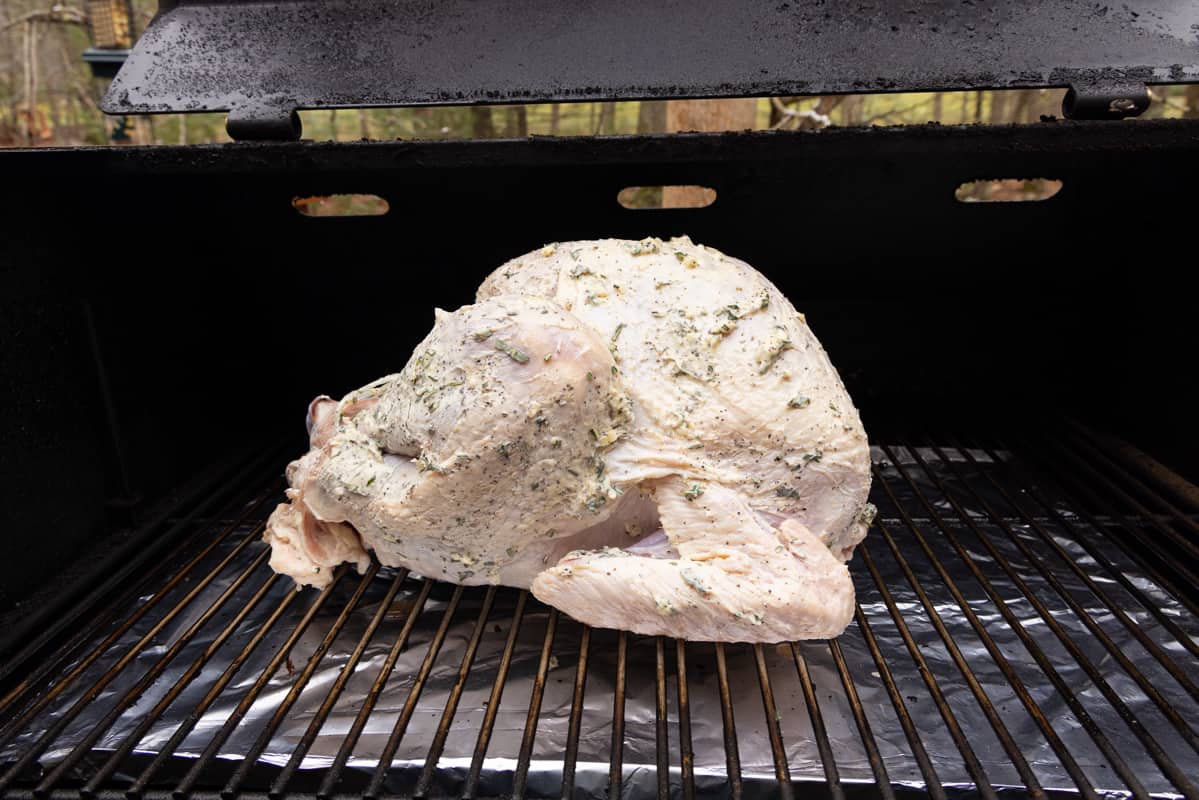
After smoking the turkey for an hour, start misting it with chicken broth every 45 minutes to add some moisture to the bird during the cooking process. It’s time to increase the temperature after the turkey has been in the smoker for three hours.
Charcoal Grill / Gas Grill
I do not advise smoking turkey on a charcoal grill. You can arrange charcoal briskets in a snake shape around the inside of the grill and only light one side of it.
As a result, the charcoal could burn more slowly and maintain a lower temperature. Unless you have a great deal of experience with it, the temperature is rather inconsistent. Try this technique first on a chicken, and please do not use it for Thanksgiving dinner.
You can use gas grills, but you’ll need to have a lot of propane on hand. The turkey will taste good, but not as good as it would if it were wood-smoked.
- Whole Turkey: Get a 10- to 14-pound turkey at your neighborhood supermarket. Most of the time, they will arrive frozen, but around Thanksgiving, you can find some incredibly amazing bargains.
- Brining a chicken in a mixture of fresh water, kosher salt, apple juice, and brine
- Seasoning: This turkey is incredibly flavorful and made with excellent ingredients. Freshly cracked black pepper, minced garlic, rosemary, thyme, and salted butter
- Wood chips: This smoked turkey has a wonderful flavor thanks to the use of fruit woods like cherry or apple wood chips. They give the bird a nice, mild smoke without overpowering the seasonings.
- Ideal side dishes: This turkey pairs wonderfully with mashed potatoes, dressing or stuffing, green beans, rolls, and a delicious pumpkin pie.
A little preparation and seasoning are in order before we begin cooking this bad boy. Now let’s prepare this bird for smoking.
The giblets inside the turkey must be removed before we can season it or light the smoker. Usually, these are put inside the turkey’s cavity in a bag.
The bird’s neck, gizzard, liver, kidneys, and heart will all be in these bag(s). The neck will be inside the turkey cavity but outside the bag.
Brining the turkey before seasoning and smoking is optional. This will help keep the chickens moist while cooking, but is not required. To brine the turkey, grab a bucket big enough to submerge the turkey fully in water, such as a 5 gallon bucket commonly found at Lowes or Home Depot.
Put all of the ingredients for the smoked turkey brine in a pot and bring it to a boil.
- 3 gallons fresh water
- 3 cups kosher salt
- 4 cups apple juice
- 2 cups dark brown sugar
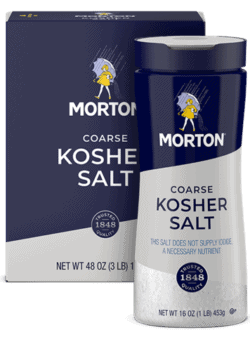
Bring to a gentle boil and stir until all of the ingredients are dissolved in the water. Remove from heat and allow to cool. You can add ice cubes to expedite the cooling process.
After removing the turkey’s gizzards, place it in a five-gallon bucket and cover it completely with the cooled brine water. Put the bucket in the fridge and let it brine for at least four hours, if not longer.
Take the turkey out of the brine and give it a quick wash in cold, fresh water. Do not save the brine for later use; instead, discard it. Always use fresh brine when brining turkey or chickens.
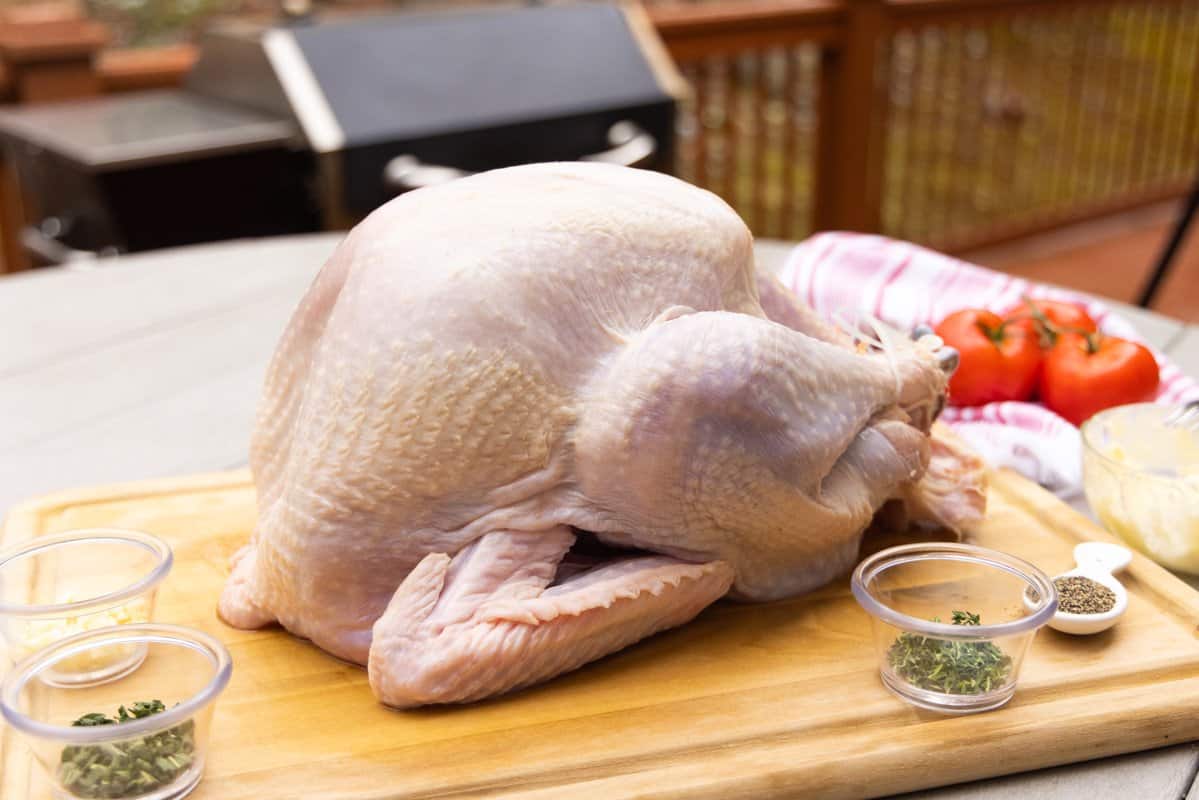
Using paper towels, thoroughly pat the chickens dry, being careful to get under any skin and around their legs. Use butcher twine to secure the legs together, or leave the turkey’s plastic leg holder in place. This keeps the breast meat from drying out more quickly than the legs and thighs and aids in the bird’s even cooking.
For this recipe for smoked turkey, we’re using salted butter and fresh herbs.
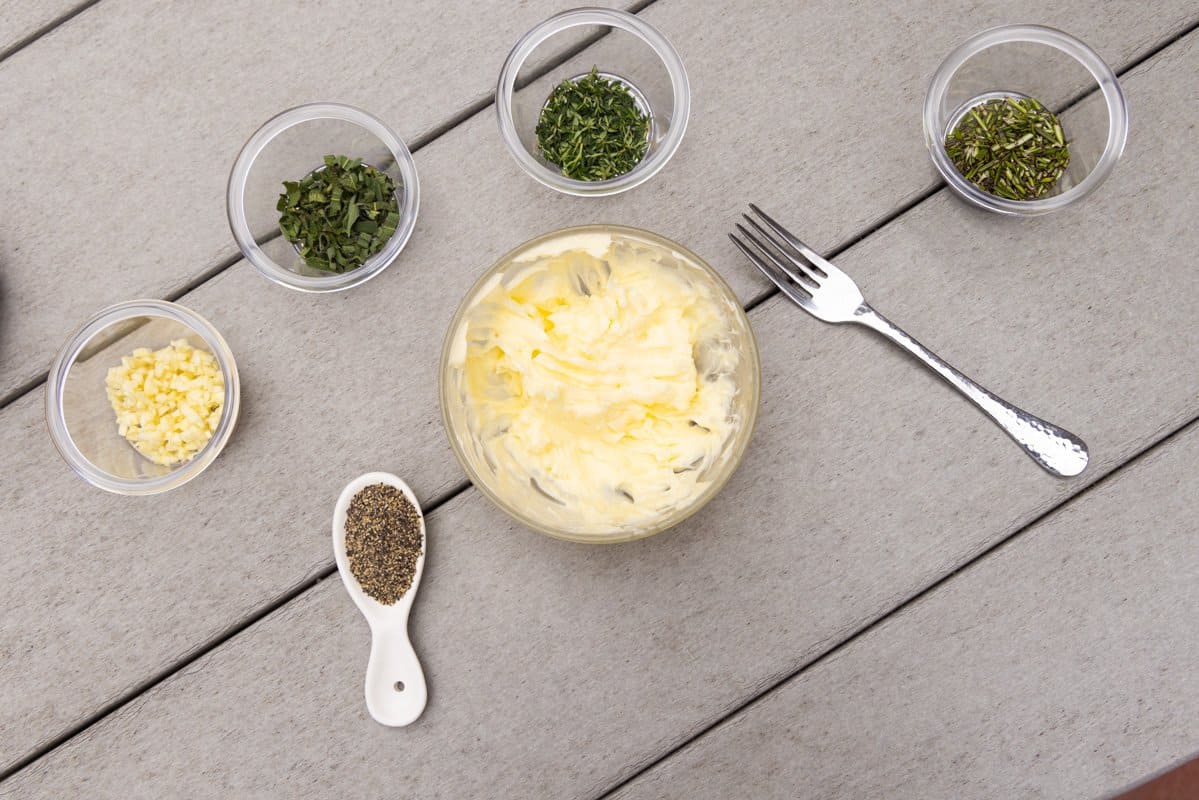
Use a microwave to soften the butter or leave it out on the counter for a few hours. Get the ingredients ready to add to the butter.
- Salted butter
- Black pepper (freshly cracked)
- Garlic (minced, not garlic powder)
- Rosemary
- Thyme
- Sage
Once the butter is soft, thoroughly combine it with the remaining seasonings.
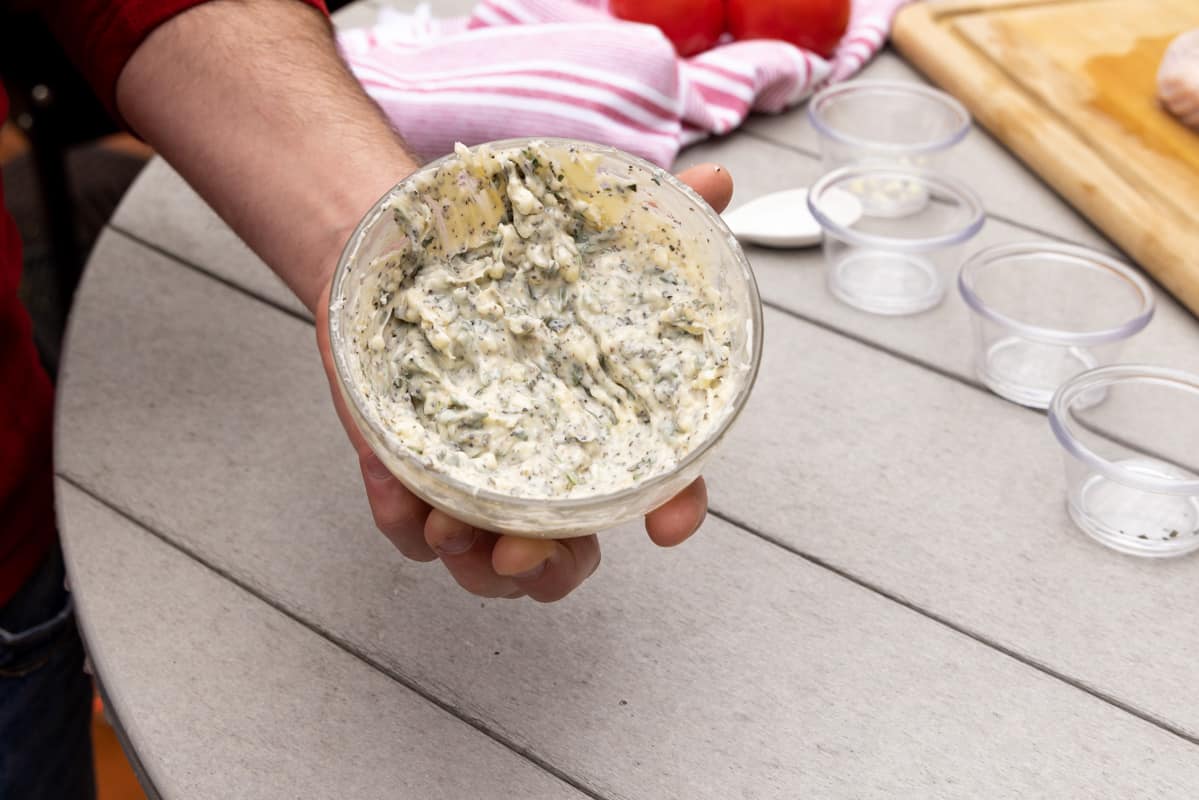
Next, spread the seasoned butter all over the turkey. Thoroughly pat the turkey dry before applying the butter all over it.
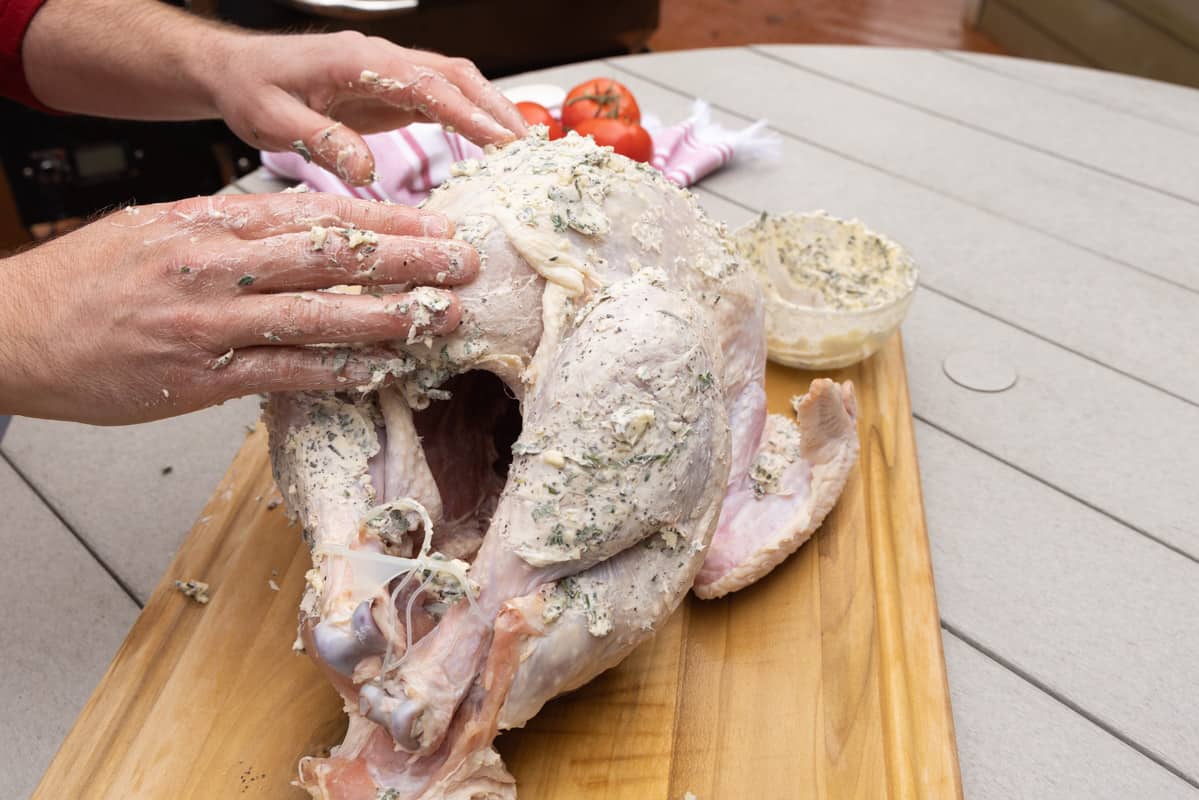
Additionally, be sure to massage the butter onto the breast meat and under the skin. This will contribute to the incredible flavor of the skin and meat.
